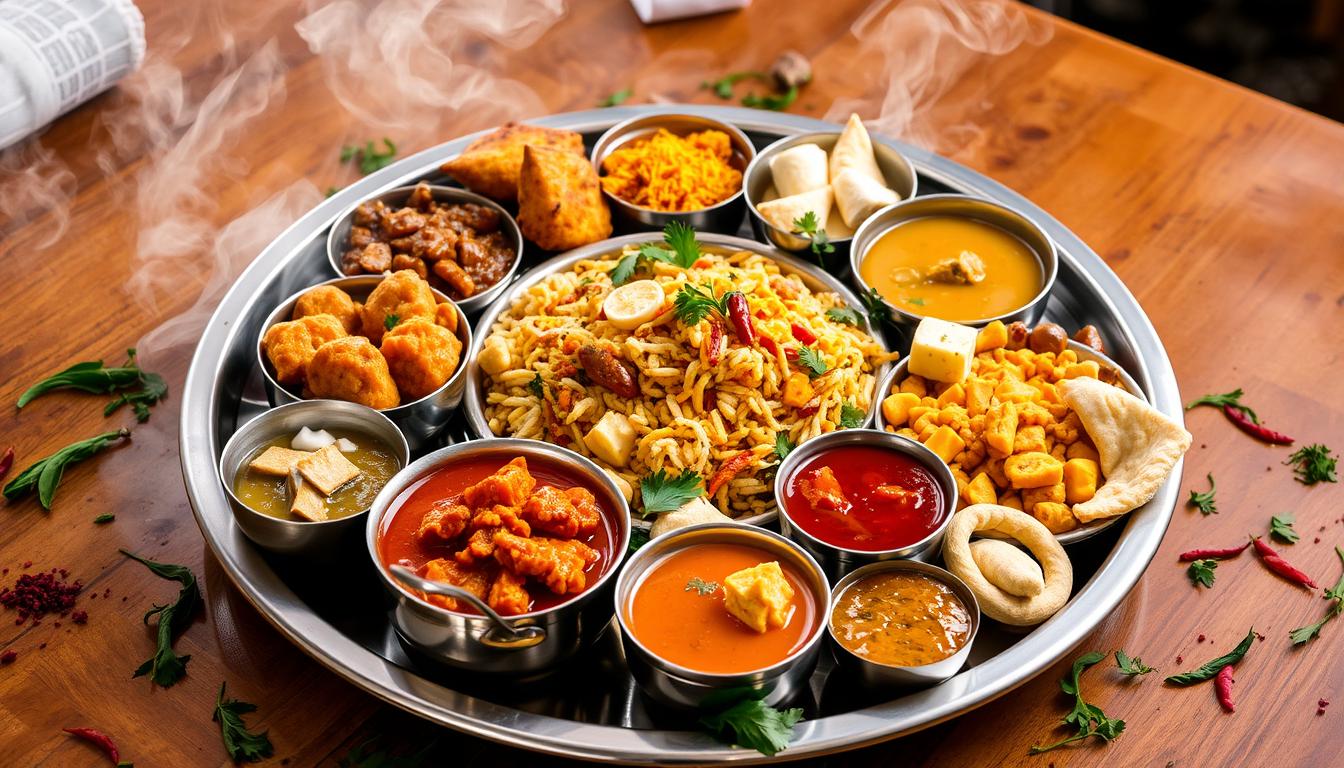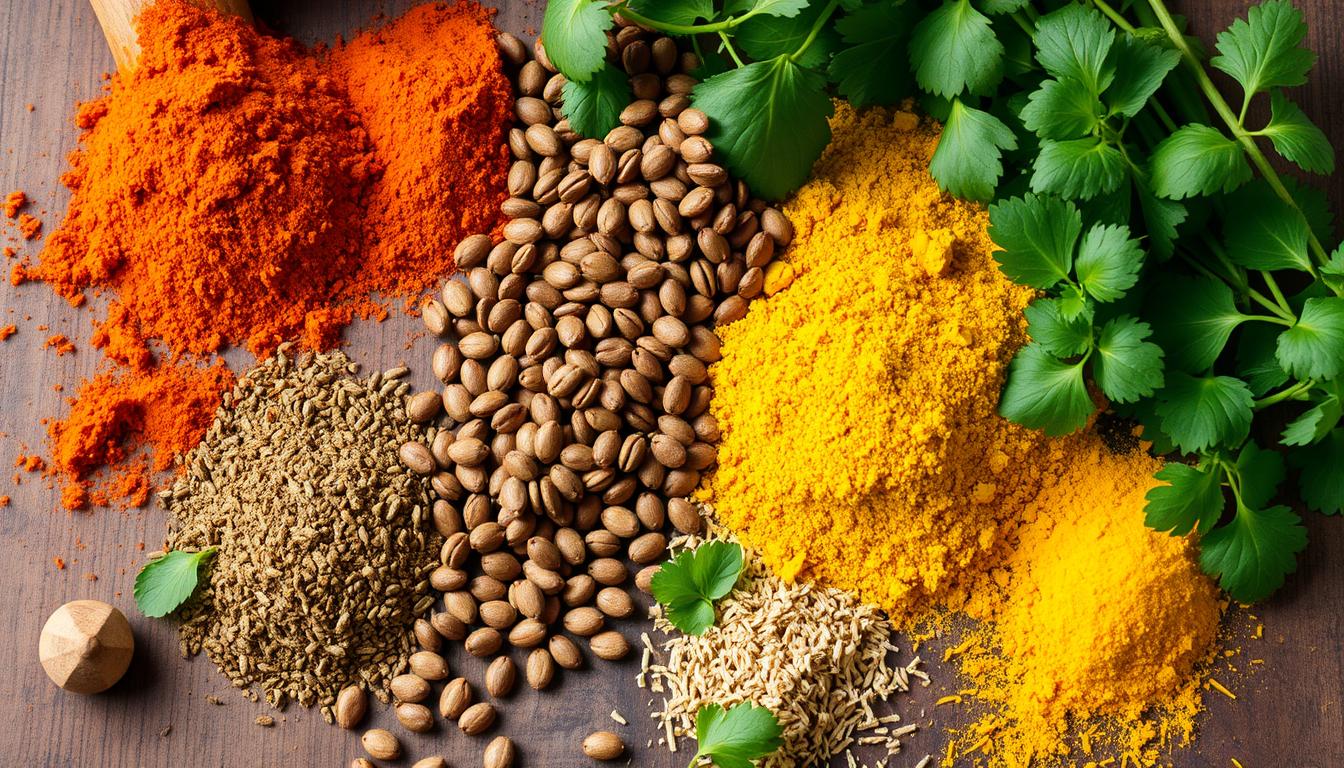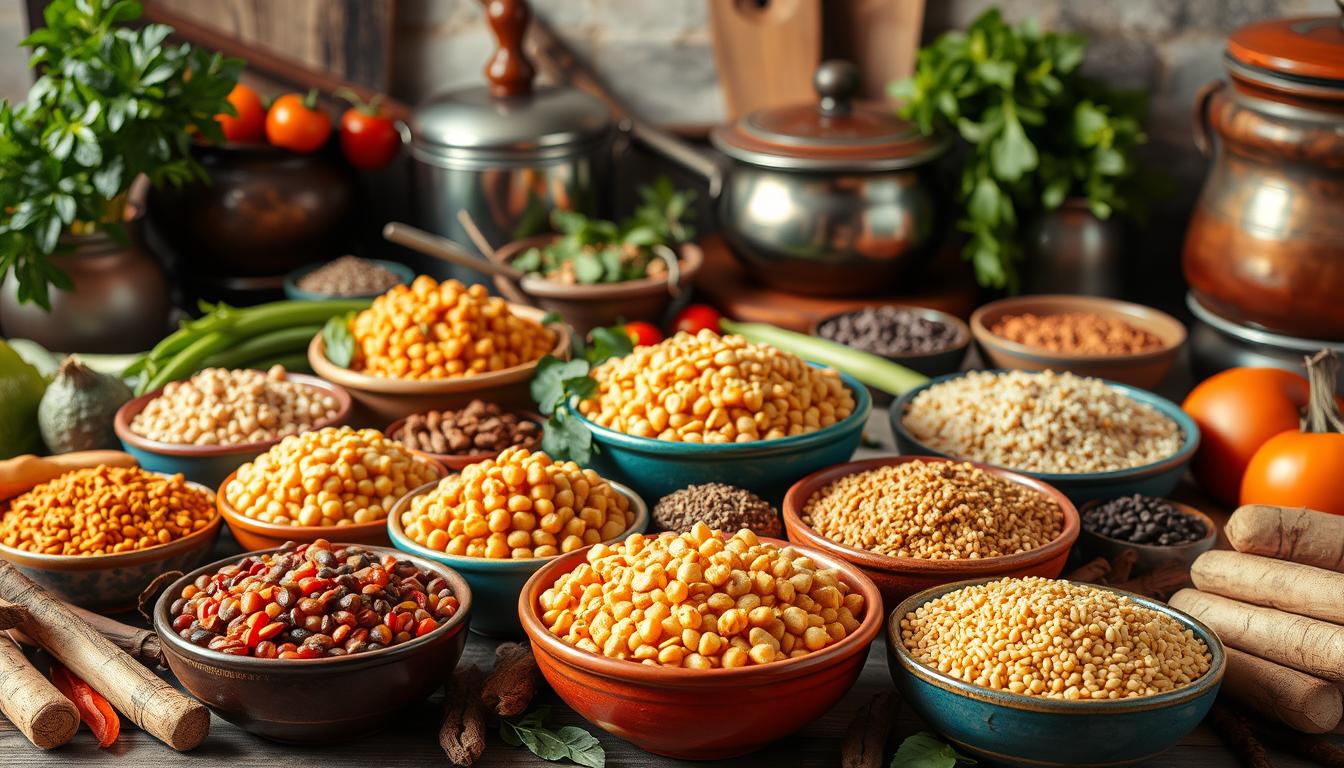Indian cuisine is known for its vibrant flavors and rich traditions. But is it really healthy? Let's explore the benefits and interesting facts about traditional Indian dishes.

Indian cooking balances spices, herbs, and whole ingredients. Turmeric fights inflammation, while cumin and coriander aid digestion. Discover how Indian food can nourish your body and mind.
Key Takeaways
- Indian cuisine is renowned for its flavorful spices and use of fresh, whole ingredients.
- Many Indian spices and herbs possess medicinal properties, such as the anti-inflammatory effects of turmeric.
- Traditional Indian cooking methods, like slow simmering and tandoor-style grilling, can preserve the nutritional value of ingredients.
- Indian vegetarian and non-vegetarian dishes offer a diverse range of protein sources.
- With proper portion control and healthy cooking techniques, Indian food can be an excellent choice for weight management.
Understanding Traditional Indian Cuisine and Its Core Elements
Indian cuisine is a mix of flavors, textures, and local specialties. It has been shaped over centuries. At its core are Indian spices, lentils, vegetables, and whole grains.
Common Ingredients in Indian Cooking
India's climate and geography have led to many spices. Spices like cumin, coriander, turmeric, and ginger add flavor and health benefits. Lentils, like dal, are key in many vegetarian dishes.
Vegetables like eggplant, okra, and cauliflower are used in curries and stir-fries.
Regional Diversity in Indian Food
India's vast landscape has led to different cuisines in each region. The north is known for rich, creamy curries. The south has lighter, coconut-based dishes.
The northwest is famous for tandoor-fired breads. The Deccan region is known for idli and dosa. This shows the depth and complexity of Indian regional cuisines.
Traditional Cooking Methods
Indian cooking techniques have been passed down for generations. They are designed to bring out the best in ingredients. Slow-simmered curries and quick stir-fries highlight the flavors of Indian spices, lentils, and vegetables.
https://youtube.com/watch?v=BdWnMVbvBwI
Understanding traditional Indian cuisine helps us value its rich cultural and culinary heritage. This heritage has shaped the vibrant and flavorful food tradition we know today.
Nutritional Profile of Indian Food Healthy Eating Patterns
Indian cuisine is known for its rich flavors and diverse dishes. But it's also packed with nutrients that support a balanced diet. Traditional Indian meals include a mix of food groups, offering essential nutrients.
At the core of an Indian meal are protein sources. These can be from plants or animals. Legumes like lentils and chickpeas are common, while chicken, fish, or lamb add variety. Also, fiber-rich foods such as vegetables, whole grains, and fruits are used. They ensure a steady intake of vitamins and minerals.
| Nutrient | Typical Indian Meal | Recommended Daily Intake |
|---|---|---|
| Protein | 20-30 grams | 46-56 grams |
| Fiber | 12-18 grams | 25-30 grams |
| Vitamin C | 30-45 mg | 75-90 mg |
| Iron | 5-8 mg | 8-18 mg |
Indian cuisine's mix of protein sources, fiber-rich foods, vitamins, and minerals makes for a balanced diet. This diet supports overall health and well-being. By enjoying Indian food, you can nourish your body while savoring delicious meals.
"The secret to a healthy Indian meal lies in its ability to balance essential nutrients, ensuring a nourishing and satisfying dining experience."
Health Benefits of Essential Indian Spices and Herbs
Indian cuisine is famous for its tasty and aromatic spices. These spices not only make food delicious but also have many health benefits. Turmeric fights inflammation, while cumin and coriander help with digestion. For centuries, these spices have been used in traditional Indian medicine to keep people healthy.
Anti-inflammatory Properties of Turmeric
Turmeric, the bright yellow spice found in many Indian curries, is known for its anti-inflammatory effects. The compound curcumin in turmeric has been studied a lot. It helps reduce body inflammation, which is good for people with arthritis, joint pain, and some cancers.
Digestive Benefits of Cumin and Coriander
Cumin and coriander, two key spices in Indian cooking, are great for digestion. Cumin helps make digestive enzymes, which break down food better. Coriander can help with stomach issues like bloating and gas.
Medicinal Properties of Ginger and Garlic
Ginger and garlic are loved for their health benefits in Indian culture. Ginger boosts the immune system and can help with nausea. Garlic is full of antioxidants and antimicrobials, making it good for a healthy diet.
Adding these spices and herbs to meals makes Indian food not only tasty but also nutritious. People can enjoy the flavors of Indian cuisine while getting health benefits from these ingredients.

Protein Sources in Indian Vegetarian and Non-Vegetarian Dishes
Indian cuisine is rich in protein options for both vegetarians and non-vegetarians. It includes plant-based proteins, lean meats, and dairy products. This variety ensures a balanced intake of complete proteins.
Lentils and beans are key in vegetarian dishes, offering plenty of plant-based proteins. Dal (lentil stew), chole (chickpea curry), and rajma (red kidney bean curry) are tasty and nutritious. They are packed with essential amino acids.
Dairy products like yogurt, paneer (fresh cheese), and milk are also crucial. These dairy proteins make dishes creamy and rich. They also help in achieving a balanced, complete protein intake.
Non-vegetarians can enjoy lean meats like chicken, lamb, and seafood in Indian dishes. Tandoori chicken, mutton curry, and fish curry are great examples. They are rich in high-quality protein sources essential for muscle growth and maintenance.
| Protein Source | Examples in Indian Cuisine | Nutritional Benefits |
|---|---|---|
| Plant-based Proteins | Lentils, chickpeas, beans | Rich in amino acids, fiber, and B-vitamins |
| Dairy Proteins | Yogurt, paneer, milk | Provide complete proteins, calcium, and probiotics |
| Lean Meats | Chicken, lamb, seafood | High in protein, low in fat, and packed with essential nutrients |
Exploring the variety of protein sources in Indian cuisine can lead to a balanced diet. It meets the dietary needs and preferences of everyone.

"Indian cuisine offers a delectable and nutritious way to incorporate a variety of protein sources into one's diet."
Is Indian Food Healthy for Weight Management?
Indian cuisine is surprisingly good for weight management. It's all about portion control, balancing calories, and using healthy cooking methods. This way, you can enjoy India's rich flavors while helping your weight loss.
Portion Control in Indian Cuisine
Being mindful of portion sizes is key to a healthy weight. Indian dishes are full of tasty ingredients, making it easy to eat too much. But, by eating smaller portions and choosing nutrient-rich foods, you can enjoy Indian flavors without overeating.
Balancing Calories in Indian Meals
Indian meals are a mix of carbs, proteins, and healthy fats. This balance helps you feel full and satisfied. By picking lean proteins, whole grains, and lots of veggies, you can make tasty, healthy Indian dishes.
Healthy vs Unhealthy Cooking Methods
The cooking method used in Indian food affects its healthiness. Techniques like sautéing, grilling, or baking make dishes lower in calories and higher in nutrients. Deep-frying or using too much oil, on the other hand, adds calories and isn't good for weight loss. Choosing healthier cooking methods lets you enjoy India's flavors while helping your weight goals.
FAQ
What are the health benefits of Indian cuisine?
Indian food is packed with spices and herbs that are good for you. Turmeric, ginger, and garlic help fight inflammation. They support your overall health.
Indian dishes also have lots of fiber from lentils, whole grains, and veggies. This makes for a healthy and balanced diet.
How does the diversity of Indian regional cuisines contribute to its nutritional profile?
Indian food is very diverse, with each area having its own special dishes. This diversity means Indian food has a wide range of ingredients.
In the north, you find lentils and whole grains. The south is known for seafood and coconut dishes. This variety ensures Indian food is full of nutrients.
What are some of the key spices and herbs used in traditional Indian cooking?
Indian cooking uses a lot of spices and herbs for flavor and health benefits. Turmeric, cumin, coriander, and cardamom are common. They help with inflammation, digestion, and boost the immune system.
How can Indian cuisine support weight management?
Indian food can help with weight management if eaten in moderation. Many dishes are made with lentils, veggies, and whole grains. These are full of nutrients and fiber, making you feel full.
But, be careful of portion sizes. Avoid fried or creamy dishes, as they are high in calories and unhealthy fats.
What are some of the protein-rich options in Indian vegetarian and non-vegetarian dishes?
Indian food has many protein sources, for both vegetarians and meat-eaters. Vegetarians can enjoy lentils, beans, chickpeas, and paneer. Non-vegetarians have lean meats like chicken and fish, plus eggs.
These protein-rich foods help make meals balanced and nutritious. They support your health and well-being.
Powered by Froala Editor
